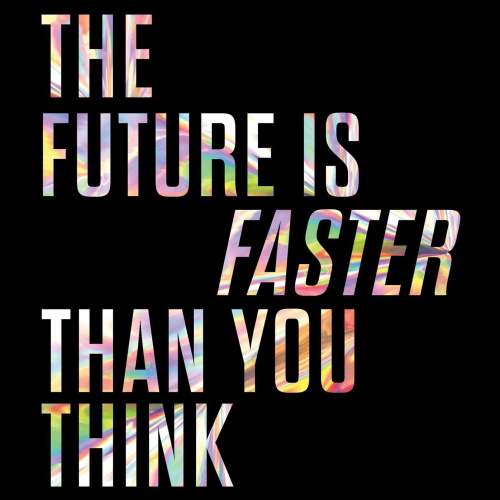The Future Is Faster Than You Think
Book about future written by Peter Diamandis and Steven Kotler
Technology is accelerating far more quickly than anyone could have imagined. During the next decade, we will experience more upheaval and create more wealth than we have in the past hundred years. In this gripping and insightful roadmap to our near future, Diamandis and Kotler investigate how wave after wave of exponentially accelerating technologies will impact both our daily lives and society as a whole. What happens as AI, robotics, virtual reality, digital biology, and sensors crash into 3D printing, blockchain, and global gigabit networks? How will these convergences transform today’s legacy industries? What will happen to the way we raise our kids, govern our nations, and care for our planet?
Diamandis, a space-entrepreneur-turned-innovation-pioneer, and Kotler, bestselling author and peak performance expert, probe the science of technological convergence and how it will reinvent every part of our lives—transportation, retail, advertising, education, health, entertainment, food, and finance—taking humanity into uncharted territories and reimagining the world as we know it. As indispensable as it is gripping, The Future Is Faster Than You Think provides a prescient look at our impending future.
Book Review
Perhaps the last line of the book is its best introduction: "Take a deep breath and don’t blink, because, ready or not, here comes tomorrow." Diamandis and Kotler provide a rapid journey through recent technological advances, highlighting, in places, just how fast things are improving today compared to previously.
They throw a lot of facts and predictions at the reader, so yes, of course, some of it is off the mark, and overall it's probably a little over-optimistic. But, generally speaking it portrays a realistic outlook on what our world might look like in the not-so-distant future.
Highlights
Here are 101 key points from The Future Is Faster Than You Think. The book was published in 2020, so I've added up-to-date statuses against some of their predictions - not to point out where they were wrong (or right) as, generally, any differences only need a small shift in the timescale rather than a fundamental change in how the technology itself is developing (well, maybe except for Hyperloop!).
- Formerly independent waves of exponentially accelerating technology are beginning to converge.
- By mid-2019, over $ 1 billion had been invested in at least twenty-five different flying car companies. *Mar 2024: UK government announces Future of Flight action plan to get flying taxis launched by 2026
- Distributed electric propulsion (DEP) engines are 95 percent efficient compared to gasoline’s 28 percent.
- Waymo intends to deliver a million trips per day in 2020. *2023 - served over 700,000 ride-hailing trips with public riders and no human driver.
- Hyperloop certification and aerial ridesharing by 2023. *2023: Hyperloop One declared bankruptcy but other companies continue to pursue the idea
- While it seemingly decimated industries a study found the net created 2.6 new jobs for each one it extinguished.
- In 1956, our computers were capable of ten thousand FLOPS. In 2015, this had become one quadrillion FLOPS. *June 2022: Frontier reaches 1102 quadrillion FLOPS
- Every time an exponential technology reaches the end of its usefulness, another arises to take its place.
- Rose’s Law: The number of qubits in a quantum computer doubles every year.
- In the 2017 competition for Japan’s national literary prize, an AI-written novel made it to the final round of judging.
- It took forty days (of learning by playing itself) for AlphaGo Zero to become the undisputed best Go player on Earth.
- The FDA has approved AI for emergency room duty, where it’s better than doctors at predicting sudden death from respiratory or cardiac failure.
- 3G ushered in a new era of acceleration as bandwidth costs began to plummet— at a staggeringly consistent 35 percent per year.
- Alphabet is now rolling out Project Loon to replace terrestrial cell towers with stratospherically located balloons. *Jan 2021: shut down due to lack of profitability
- Since arteries in the finger are closer to the surface than those in the wrist, the Oura gets a much better picture of what’s happening in the heart.
- By 2030, Stanford researchers estimate 500 billion connected devices in the Internet of Things (IoT). *2023 = 15.1 billion, 2030 forecast = 30 billion
- ASIMO, like the other robots sent into Fukushima, turned out to be too unreliable for disaster mitigation. *2024: ATLAS is getting there!
- 2019 brought the first commercially available robo-mason, capable of laying a thousand bricks an hour.
- By the middle twenties, estimates put the VR market around $ 35 billion or so. *2024: estimate for this year = $ 67 billion
- On a 2018 ISS mission, when an astronaut broke his finger, they 3-D printed a splint.
- 3-D printed organs are predicted to hit the market by 2023. *2024: multi-layer mini-organs being used in research
- Materials Genome Initiative has the potential to get Perovskite's conversion efficiency up to 66 percent. *2024: currently 25%
- A bioengineer at Harvard recently stored seven hundred terabytes of data in a single gram of DNA.
- Biotechnology is turning the fundamental components of life — our genes, proteins, cells — into tools for manipulating life.
- A few years from now, companies like Illumina are promising to sequencing a human genome in an hour and for $ 100. *2022: world record set at 5 hours
- In N-of-1 medicine, every treatment you receive has been specifically designed for you— your genome, transcriptome, proteome, microbiome, and all the rest.
- “Saved time” turns out to be one of the major benefits of technology.
- Labour-saving devices have managed to reduce housework, our agreed upon least favourite activity, from fifty-eight hours a week in 1900 to 1.5 in 2011.
- The number of ICOs per quarter has also ballooned, from roughly a dozen during the first quarter of 2017, to over a hundred by the last quarter of 2017.
- Tools once accessible to only the wealthiest companies and the largest government labs are now available at near-zero prices t just about anyone.
- One of the by-products of our hyper-connected world is that these extraordinary individuals will no longer be casualties of class, country, or culture.
- In 2017, USC neuroscientist Dong Song repurposed epilepsy seizure-control neural implants to produce a 30 percent boost in memory.
- The business model changes of the last few decades are nowhere near the changes that are coming.
- In the late 1800s, a good idea for a new business was to take an existing tool and add electricity to it... the same is now happening with AI.
- Retail is nestled at the convergence of communications, energy, and transportation breakthroughs.
- In 2018, Google Duplex, their next generation digital assistant, made a reservation at a restaurant and the person on the other end of the phone had any idea they were talking to an AI.
- Beyond Verbal's customer service can tell whether the person on the phone is about to blow a gasket, is genuinely excited, or anything in between.
- In 2016, Domino’s Robotic Unit, or DRU for short, became the first home delivery pizza robot.
- As human labour costs continue to climb, robots won’t just be coming, they’ll be here, there, and everywhere.
- With 3-D printing, retailers can now purchase raw materials and print inventory themselves, either at warehouses or in the retail outlet.
- By replacing premade ingredients with premade experiences, the experience economy is a new kind of disruptive business model.
- At the turn of the Industrial Revolution, the richest people on the planet didn’t have air-conditioning, running water, or indoor plumbing.
- Less than two decades after the arrival of the internet, Google and Facebook together command more advertising dollars than all print media on the planet.
- The entire social media marketing market will vanish. How long will that take? We give it ten to twelve years.
- We’re heading toward a future where AI will make the majority of our buying decisions.
- By fall 2018, Netflix subscriptions had rocketed to 137 million, and experts predict that could double over the next few years. *2023: 260 million
- How long before we get new movies with old stars? Our hunch, not very long.
- Immersion marks the third shift in content, a transformation that has everything to do with attention.
- NeoSensory, has built an “exoskin” that’s designed to work in VR worlds so that you can feel their touch.”
- Soon, with in-theatre sensing and affective computing, emotionally driven storytelling will become just another part of the moviegoing experience.
- Over the next five years, AR is projected to create a $ 90 billion market.
- 263 million children worldwide currently lack access to basic education.
- AI gives us the ability to create individually customized learning environments.
- If nothing changes, by 2027, the healthcare industry will consume nearly 20 percent of the US GDP.
- The list of once multimillion-dollar medical machines now being made into portable and even wearable sensors — could fill a textbook.
- When we understand your genome, the thinking goes, we’ll know how to optimize “you.”
- Genome Project-Write, which is the farther future — an attempt to write a human genome from scratch.
- Half of the thirty-two thousand most common genetic disorders are caused by an error in a single base pair.
- NASA is planning to launch the first human exploration mission to Mars in the 2030s. *Mar 2024: unchanged
- Most of Today's surgical robots are cobots — meaning the robot assists the surgeon rather than replacing the surgeon.
- Celularity scientists have also figured out how to weaponize placental natural killer cells (pNK cells).
- In late 2018, Insilico was generating novel molecules in fewer than forty-six days, and this included not just the initial discovery, but also the synthesis of the drug and its experimental validation in computer simulations.
- Kurzweil thinks longevity escape velocity is about twelve years away, while de Grey puts it thirty years out. *Mar 2024: brought forward to 2029
- Rapamycin extends the lives of mice by as much as 16 percent.
- A half-dozen companies are now involved in this effort, producing about a dozen drugs that obliterate zombie cells. *2024: lots, lots more targeting senescent cells
- In 2017, Samumed published the results of a small study on knee osteoarthritis - all sixty-one patients saw improvement. *2024: now called Biosplice - phase 3 trial extension continues to demonstrate clinically significant results
- Significantly extending human lifespan has changed from a question of “if” to a matter of “when.”
- The accounting firm KPMG predicts the car insurance market could shrink by an astounding 60 percent by 2040.
- Decentralized, peer-to-peer insurance, or what’s become known as “crowdsurance” eliminates the middleman.
- The term McKinsey coined to describe this kind of AI-driven, sensor-laden insurance is “pay-as-you-live.”
- While over two billion people in the world still lack bank accounts, nearly all of them have mobile phones.
- Every day, roughly 60 percent of all market trades are made by computer.
- Denmark stopped printing money in 2017. *more that they outsourced it to France and Finland. 2024: planning a new banknote series for 2028 but will omit largest denomination as only 10 per cent of physical payments in stores use cash
- AI-driven, VR real estate platforms will allow you to explore any property on the market.
- Floating cities are a proposed solution to a trilogy of modern problems: rising seas, skyrocketing populations, and threatened ecosystems.
- Your robo-chef, really nothing more than a pair of articulated arms with a touch screen interface, will be in your kitchen soon. *2024: several consumer models now available
- Improving photosynthesis can get us more than halfway to doubling overall crop production.
- 70 percent of humanity will live in cities by 2025. *2024: UN forecasts 68% by 2050
- Plenty Unlimited's vertical farms produces yields 350 times greater than outdoor farmland, and uses less than 1 percent as much water.
- Today, 50 percent of all habitable land on Earth is used for agriculture.
- Cultured meat uses 99 percent less land, 82 to 96 percent less water, and produces 78 to 96 percent less greenhouse gases.
- Memphis believes accelerating technology will bring that cultured burger cost down to around $ 5 within a few years. *2023: down to $9 ($17 per pound)
- By 2025, according to the UN, half the globe will be water stressed.
- Every 88 minutes, 470 exajoules of solar energy hit our planet, which is as much as humanity consumes in a year.
- By 2022, your average mid-range electric vehicle model will get 275 miles on a full charge. *2023: almost 300 miles
- A fully charged Tesla Model-S could power three American homes for almost twenty-four hours.
- A single BioCarbon Engineering pilot can fly six drones at once, planting a staggering one hundred thousand trees a day.
- Stanford researchers give us three generations to halt species die-off before ecosystem services shut down in earnest.
- In 1790, 90 percent of all Americans made their living as farmers; today it’s less than 2 percent.
- Robots are coming for everyone from truckers and taxi drivers to warehouse workers and retail employees.
- Exponential technology, in Nick Bostrom's opinion, had a bad habit of becoming existential risk.
- Our brains emerged in an era of immediacy, so we’re a shortsighted species.
- In Estonia, 99 percent of all public services are online,
- Migration is an innovation accelerant.
- Even if we manage to halt global warming at two degrees, extreme weather will still displace 130 million people.
- Whatever it might cost us to implement these solutions to prevent 4 degrees C of warming, it’s going to be a whole lot cheaper than finding new homes for 700 million people.
- By 2050, some 66 to 75 percent of the world will have urbanized... a mass movement some 2.5 billion strong.
- Smart city solutions could reduce urban greenhouse gases some 15 percent and save water.
- Musk views the establishment of a Mars colony as a contingency plan for humanity and a problem to be solved this decade. *2024: planning crewed mission as early as 2029
- Neurotech sitting atop the head won’t be able to capture signals at any useful resolution,
- Over the next century, technological acceleration may actually disrupt the progress of biologically based intelligence on Earth.
Visit website: https://futurefasterbook.com/
Peter Diamandis
Founder/co-founder of XPRIZE, Singularity University, Human Longevity Inc., and more
Details last updated 24-Apr-2021
Mentioned in this Resource
Steven Kotler
American author, journalist, and entrepreneur best known for his non-fiction books, including Abundance and A Small Furry Prayer
The Future Is Faster Than You Think is also referenced in the following:
ARDD 2021 - 8th Aging Research and Drug Discovery Meeting
31-Aug-2021 to 03-Sep-2021
Online event about latest progress in the molecular, cellular and organismal basis of aging organized by University of Copenhagen chaired by Morten Scheibye-Knudsen, Daniela Bakula and Alex Zhavoronkov, and with many speakers.







